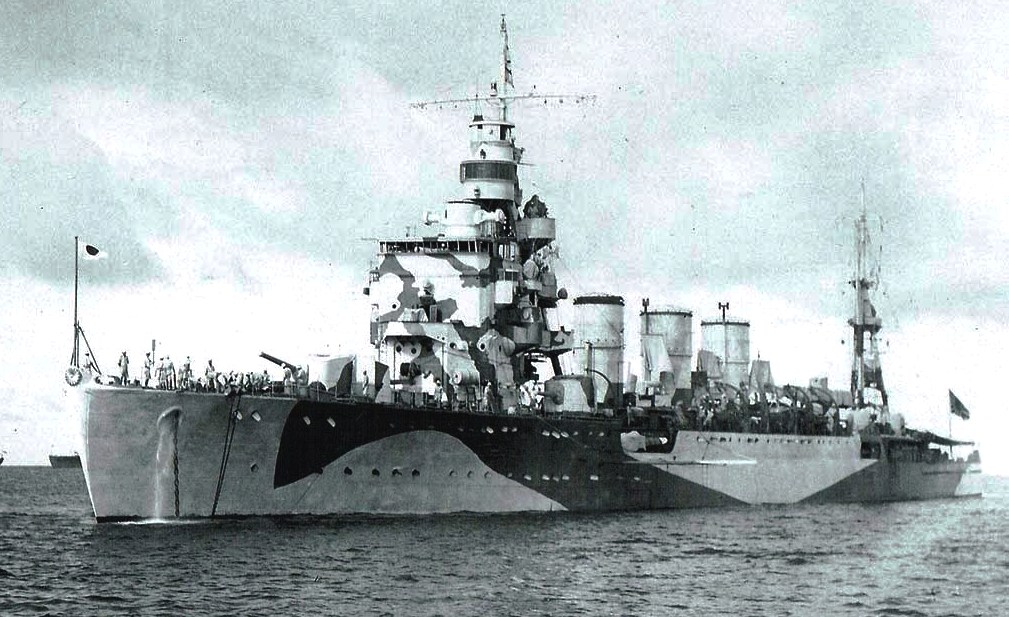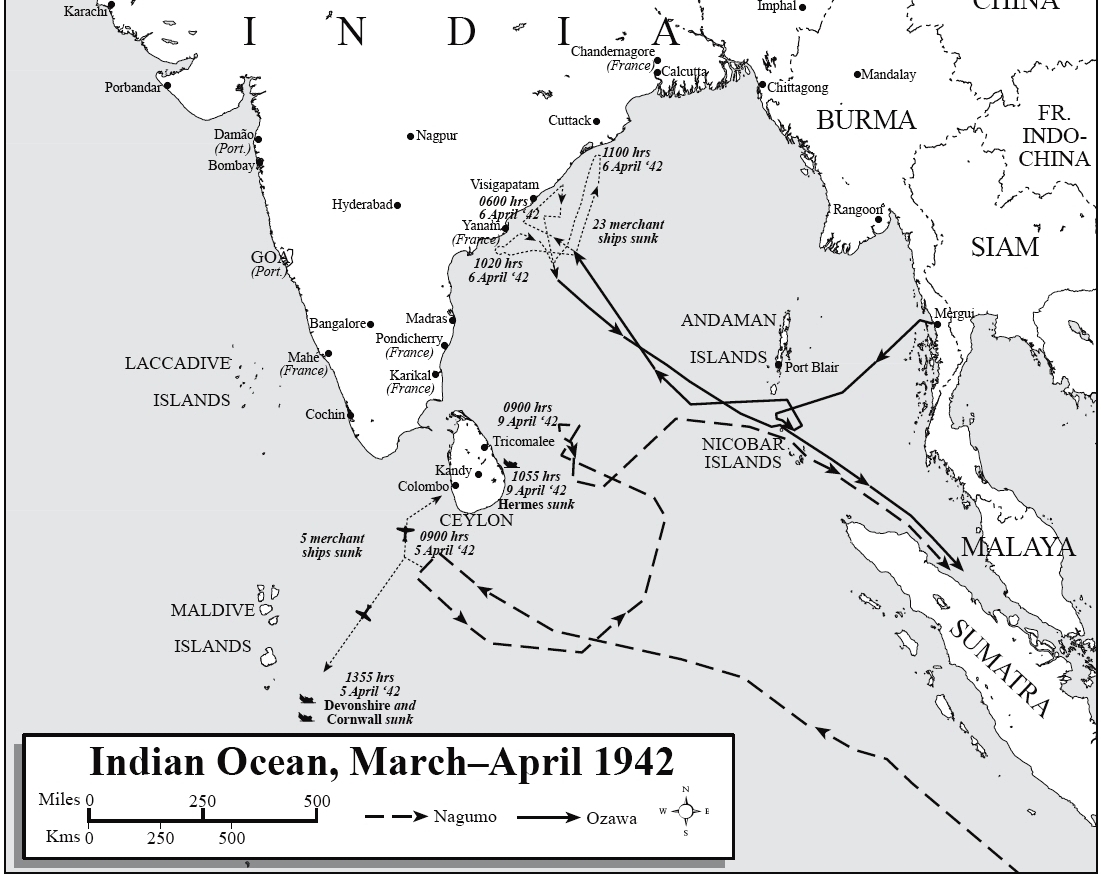6 April 1942:
Bay of Bengal. At about 0600, the three ships of Ozawa’s Northern Group attack and sink the 5,381-ton Norwegian tanker ELSA. After 0730, KUMANO and SUZUYA and destroyer SHIRAKUMO attack a six-ship convoy and sink 4,986-ton American Export Line’s
EXMOOR (ex-CITY OF ST. JOSEPH), 9,066-ton British freighter MALDA, 7,718-ton British freighter AUTOCLYCUS and 2,441-ton British freighter SHINKUANG at 19N, 86E. Ozawa's cruisers also sink 6,622-ton British freighter INDORA
and Captain J. H. Gregory’s British India Line’s 4,921-ton cargo ship SILKSWORTH. About 50 of SILKSWORTH's mostly Chinese crewmen survive.
Temporarily detached from the rest of Ozawa’s Center Group, YURA and YUGIRI sink 1,279-ton Dutch merchant BATAVIA en route from Calcutta to Karachi. YURA and YUGIRI also sink 1,279-ton Dutch freighter BANJOEWANGI and 3,471-ton British
steamer TAKSANG.
The rest of the Center Group, RYUJO, CHOKAI and ASAGIRI, sink five ships:
5,491-ton American freighter BIENVILLE is bombed by RYUJO's aircraft. She is finished off by gunfire from CHOKAI, and reportedly also from RYUJO, and then by a torpedo from CHOKAI.
6,426-ton British cargo ship GANGES is attacked by one of CHOKAI’s floatplanes and two of RYUJO’s aircraft, and is then sunk by gunfire from the surface ships, including gunfire from RYUJO.
2,646-ton British ship SINKIANG is attacked by aircraft and then likewise sunk by gunfire.
5,686-ton American freighter SELMA CITY is bombed by CHOKAI’s floatplanes. She is also attacked and hit by two aircraft from RYUJO, but by then is already sinking and abandoned.
2,073-ton Dutch freighter VAN DER CAPELLEN is bombed and damaged by RYUJO's aircraft and sinks two days later.
That same day, 5,268-ton British freighter ANGLO-CANADIAN is attacked by five aircraft from RYUJO, including two armed with torpedoes, and score one hit, a bomb which does not explode but which starts a fire.
Also that day, RYUJO launches strikes against Cocanada and Vizagapatam. 3,827-ton British merchant MARION MOLLER is damaged at Vizagapatam.
Ozawa’s Southern Group sinks four ships. They first encounter disabled DARDANUS, under tow by the 5,281-ton British ship GANDARA. The three Japanese ships promptly open fire on the two merchantmen, which are finished off with
torpedoes from AMAGIRI. Two Norwegian vessels are then sunk, 4,434-ton DAGFRED and 1,515-ton HERMOD.
In all Ozawa's commerce raiding detachment sinks twenty ships of about 93,247 tons during their brief foray in the Bay of Bengal.
9 April 1942: The Attack on the British naval base at Trincomalee:
At 0600, Nagumo's Striking Force launches 132 aircraft led by Cdr Fuchida to attack the British naval base at Trincomalee, Ceylon (91 B5N2 Kate dive-bombers [18 from AKAGI, 18 from SORYU and 18 from HIRYU, 19 from SHOKAKU and 18
from ZUIKAKU] and 41 A6M2 Zeke fighters [6 from AKAGI, 9 from SORYU, 6 from HIRYU, 10 from SHOKAKU and 10 from ZUIKAKU]).
The Japanese find the harbor almost empty of warships, but sink 9,066-ton British merchant SAGAING and a "Walrus" amphibian and three crated Fairey “Albacore” aircraft she was carrying, and damage old 15-inch monitor HMS EREBUS.
Non-operational Dutch light cruiser SUMATRA is also hit, but the 800 kg bomb does not explode. Outside the harbor, southbound 4,784-ton Greek MARIONGA D. THERMIOTIS is damaged by strafing and seven men are wounded.
HARUNA launches an E8N2 “Dave” floatplane. At 0755, it spots an enemy carrier 65 miles south of the base. Between 0843 and 0853, the Striking Force launches 85 D3A Vals, (18 from SORYU, 18 from HIRYU and 18 from SHOKAKU, 17
from AKAGI and 14 from ZUIKAKU), escorted by 9 A6M Zekes (3 each from AKAGI, SORYU, HIRYU) which sink old light carrier HMS HERMES. 306 RN personnel are KIA, but hospital ship HMHS VITA, en route from Trincomalee to Colombo, arrives
and picks up over 600 survivors.
Other sailors are rescued by local craft or swim to shore. Nagumo's aircraft also find and sink Australian destroyer HMAS VAMPIRE, 8 KIA, corvette HMS HOLLYHOCK, 53 KIA, oilers ATHELSTANE and BRITISH SERGEANT and Norwegian merchant
ship NORVIKEN.
During the day, nine of the Royal Air Force’s No. 11 Squadron’s Bristol "Blenheim" bombers attack KONGO, but score no hits and lose five four of their number to Nagumo's Combat Air Patrol "Zekes" and another is lost during the
return flight when they encounter three Zekes from HIRYU returning from the attack on HERMES. BatDiv3 and the Striking Force continue heading SE.
10 April 1942:
YURA arrives at Penang.
11 April 1942:
Departs Penang with Ozawa's Force and arrives at Singapore that same day.
20 April 1942:
Arrives at Sasebo. Captain (later Rear Admiral) Sato Shiro (former CO of AS JINGEI) assumes command. Captain Miyoshi is later reassigned as CO of MUTSU and is lost with her in 1943.
That same day, YURA begins a refit.
3 May 1942:
Drydocked.
10 May 1942:
YURA is transferred as flagship of Rear Admiral (later Vice Admiral) Nishimura Shoji's (former CO of HARUNA) DesRon 4.
11 May 1942:
Undocked.
19 May 1942:
The refit is completed. Departs Sasebo.
20 May 1942:
Arrives at Hashirajima.
27 May 1942: “MI” Sakusen (Operation "MI") - The Battle of Midway:
DesRon 4's YURA departs Hashirajima with DesDivs 2 and 9's seven destroyers in Vice Admiral (later Admiral) Kondo Nobutake's (former CO of KONGO) Second Fleet, Strike Force, Main Body's Vice Admiral Mikawa Gunichi's (former CO of KIRISHIMA) BatDiv 3/1's KONGO and HIEI, Kondo's CruDiv 4's ATAGO and CHOKAI, Vice Admiral (Admiral, posthumously) Takagi Takeo's (former CO of MUTSU) CruDiv 5's MYOKO and HAGURO, DesDiv 2's MURASAME, SAMIDARE, HARUSAME and YUDACHI, DesDiv 9's ASAGUMO, MINEGUMO and NATSUGUMO.
19 June 1942:
Arrives at Komatsushima harbor, Shikoku.
20 June 1942:
Rear Admiral (later Vice Admiral) Takama Tamotsu (former CO of HARUNA) assumes command of DesRon 4. Rear Admiral Nishimura is reassigned as ComCruDiv 7.
7 August 1942: American Operation "Watchtower" - The Invasion of Guadalcanal, Solomons:
Rear Admiral (later Admiral) Richmond K. Turner's Amphibious Task Force 62, covered by Vice Admiral (later Admiral) Frank J. Fletcher's Task Force 61 and Rear Admiral (later Admiral) John S. McCain's Task Force 63's land-based aircraft, lands MajGen (later Gen/MOH/Commandant) Alexander A. Vandergrift's 1st Marine Division on Florida, Tulagi, Gavutu, Tanambogo and Guadalcanal opening a seven-month campaign to take the island.
11 August 1942:
The YURA departs Hashirajima for Truk with Vice Admiral Kondo's Second Fleet, Support Force's BatDiv 1's MUTSU, CruDiv 5's HAGURO, MYOKO and NACHI, CruDiv 4's TAKAO and MAYA, seaplane tender CHITOSE, DesDiv 9's ASAGUMO, MINEGUMO and NATSUGUMO, DesDiv 24's UMIKAZE and SUZUKAZE and DesDiv 27's SHIGURE, SHIRATSUYU, ARIAKE and YUGURE.
17 August 1942:
Arrives at Truk.
20 August 1942 - Operation "KA": The Reinforcement of Guadalcanal:
Desron 4's YURA with destroyers KUROSHIO, OYASHIO, MINEGUMO, HAYASHIO, NATSUGUMO and ASAGUMO departs Truk in Kondo's Second Fleet, Support Force's CHITOSE, CruDiv 4's ATAGO, TAKAO and MAYA, CruDiv 5's MYOKO and HAGURO with Rear Admiral (later Vice Admiral) Abe Hiroaki's (former CO of FUSO) Vanguard Force's BatDiv 11's HIEI and KIRISHIMA, CruDiv 7's KUMANO and SUZUYA, CruDiv 8's CHIKUMA and Desron 10's light cruiser NAGARA with NOWAKI, TANIKAZE and MAIKAZE.
Kondo's Second Fleet joins Vice Admiral (Admiral, posthumously) Nagumo Chuichi's (former CO of KIRISHIMA) Third Fleet, Carrier Strike Force, Main Body's CarDiv 1's SHOKAKU, ZUIKAKU and ZUIHO, CruDiv 8's TONE and destroyers KAZAGUMO, YUGUMO, MAKIGUMO, AKIGUMO, HATSUKAZE, AKIZUKI, AMATSUKAZE and TOKITSUKAZE.
24 August 1942: The Battle of the Eastern Solomons:
Cruises NE of Guadalcanal with the Carrier Strike Force, Main Body. Vice Admiral (later Admiral) Frank J. Fletcher's Task Force 61's USS SARATOGA (CV-3) and ENTERPRISE (CV-6) launch aircraft that find and sink light carrier RYUJO. In turn, CarDiv 1's SHOKAKU and ZUIKAKU launch aircraft that find and hit ENTERPRISE with three bombs. That evening, aircraft from SARATOGA damage seaplane carrier CHITOSE.
5 September 1942:
Arrives at Truk.
9 September 1942:
Departs Truk with the Combined Fleet. Cruises E of Guadalcanal.
22 September 1942:
Arrives at the Shortland Islands.
23 September 1942:
Departs Shortland for Rabaul.
24 September 1942:
Recalled to Shortland.
25 September 1942:
Shortland. Attacked by two Boeing B-17 "Flying Fortress" bombers of the 11th Bomb Group based at Espirtu Santo. Slightly damaged by a small bomb.
5 October 1942:
Departs Shortland for Kieta, Bougainville. Recalled to Shortland that same day.
11 October 1942:
LtCdr Lucius D. Chappell's USS SCULPIN (SS-192) claims a torpedo hit forward of YURA's bridge that inflicts minor damage. Chappell says SCULPIN is driven off by the cruiser's gunfire, but postwar analysis fails to confirm this attack and YURA is not damaged this day.
12 October 1942:
Departs Shortland. Escorts seaplane tenders NISSHIN and CHITOSE that are returning from a transport run to Guadalcanal.
14 October 1942:
At 2200, YURA, light cruiser SENDAI, tender NISSHIN and destroyers ASAGUMO, AKATSUKI, IKAZUCHI and SHIRAYUKI land 1,129 troops, four field guns, four rapid-fire guns, ammunitions and provisions on Cape Esperance, Guadalcanal.
15 October 1942:
Returns to Shortland.
17 October 1942:
YURA departs Shortland on a troop transport run to Guadalcanal with the “Tokyo Express” comprised by SENDAI, light cruiser TATSUTA and 15 destroyers. They carry 2,100 troops each way and deliver field artillery pieces and anti-tank guns.
18 October 1942:
Choiseul Island. Enroute back to Shortland, YURA is attacked by LtCdr John R. Craig's USS GRAMPUS (SS-207) at 07-47S, 157-19E. Craig fires four Mark-14 torpedoes at YURA. One hits but does not explode. YURA departs the area with just a dent in her port side.
23 October 1942:
Departs Shortland for Guadalcanal, but is recalled and returns the same day.
24 October 1942:
At 1500, YURA departs Shortland to bombard Guadalcanal with the No. 2 Attack Unit consisting of Rear Admiral Takama Tamotsu’s (former CO of HARUNA) flagship DesDiv 61's AKIZUKI, DesDiv 9’s HARUSAME, MURASAME and YUDACHI.
25 October 1942:
N entrance to Indispensable Strait, off Guadalcanal. At 1300, YURA is attacked by LtCdr John Eldridge’s five SBD dive-bombers of VS-71 and hit aft by two bombs near the engine room. She floods and settles by the stern. After receiving reports of the attack, Vice Admiral Mikawa, CINC, Eighth Fleet, cancels Rear Admiral Takama's bombardment mission. The No. 2 Attack Unit reverses course back towards Shortland.
At 1415, YURA is attacked by three Army Bell P-39 "Airacobras" and at 1530 by four Marine SBDs, but these attacks fail to damage YURA.
At 1700, Captain Sato attempts to beach YURA on Fara Island, but she is attacked again by LtCdr Eldridge this time with four SBDs, three Grumman F4F "Wildcats" and four P-39s. Soon after this attack, the YURA is attacked by six USAAF B-17 bombers from Espiritu Santo. These attacks reignite YURA's fires.
At 1830, after her crew is taken off, destroyers HARUSAME and YUDACHI scuttle YURA with torpedoes. She breaks in two and the
bow sinks. At 1900, the stern is sunk by gunfire from YUDACHI at 08-15S, 159-57E. 135 men are KIA or WIA.
20 November 1942:
Removed from the Navy List.
Authors' Notes:
[1] Mt. Niitaka, located in Formosa (now Taiwan), is then the highest point in the Japanese Empire.
[2] Original Dutch reaserch by Jan Visser of the "Royal Netherlands Navy Warships in World War II" website at http://leden.tref.nl/~jviss000/Default.htm
Special thanks for assistance in researching the IJN officers mentioned in this TROM go to Mr. Jean-François Masson of Canada. Thanks also goes to Aldert Gritter/"Adm. Gurita" and Bram of the Netherlands.
Photo credit goes to Kaijnsha, History of Japanese Cruisers via reader Berend van der Wal of the Netherlands.
Thanks to Rob Stuart of Canada for additional info about "Operation C". For more info on "Operation C" please see Rob's splendid 20 Ships, Not 23: Ozawa’s Score,
5-6 April 1942. NB: Older map on this TROM page erroneously shows 23 ships sunk.
Thanks also go to J-air reader SteveC for casualty info.
- Bob Hackett and Sander Kingsepp.
Back to
Cruiser Page




